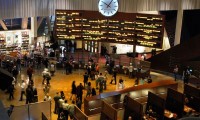Behind the camera this time is Eduardo Serra, the French cinematographer whose works include Girl With a Pearl Earring and many of the later films of Claude Chabrol; once the film has left the city and its black-walled Ministry of Magic, Serra’s images becomes warmer than those in Order of the Phoenix and Half-Blood Prince, with gorgeous landscapes that emphasize the smallness of these teenagers as they try to defeat a mad and murderous army. The composer is Alexandre Desplat, whose superb recent scores include The King’s Speech and The Tree of Life; his music here is more delicate than any other Potter score (John Williams’ original theme is barely to be heard). Mark Day again serves as Yates’ editor, keeping the pace moving forward even as the characters are in stasis. Stuart Craig is the production designer, as he’s been all along; note the subtle way the sequences in the Muggle world, although set in ordinary places like cafes and public restrooms, are slightly off-kilter, odd in a way that suggests a world alien to witches and wizards. The special effects, often cartoonish and obvious in 2001 (although state-of-the-art at the time), have become so realistic that they seem as real as the sets, and special note should be made of a lovely, distinctive animated sequence that explains the story of the Deathly Hallows themselves.
THE BIJOU RETROSPECTIVE: “Harry Potter and the Deathly Hallows (Part 1)”
More articles by Mitch Salem »
Written by: Mitch Salem
Tags: adventure, blockbuster, deathly hallows, epic, fantasy, franchise, grint, harry potter, kloves, radcliffe, retrospective, rowling, summer, The Bijou, watson, yates
When the announcement was made that Warner Bros would split HARRY POTTER AND THE DEATHLY HALLOWS into 2 full-length movies, there was a certain amount of cynicism about studio greed–and, indeed, why not pick up an extra billion or so if the opportunity arises? But really, J.K. Rowling’s novels have all been stuffed so full of plot that any of the adaptations could have been 2 movies long–as it is, readers had been complaining all along about the scenes and storylines that had to be cut for time. (For that matter, this season HBO spent 10 hours on a single volume of Game of Thrones–just nominated for a slew of Emmys–and nobody seemed to have a problem with that.)
Dividing Deathly Hallows in particular, though, guaranteed that the first film would be what is almost certainly the bleakest, most unsettling movie in the history of giant Hollywood franchises–a picture so awash in futility and death that if it were a standalone project, it probably couldn’t get financed, much less muster a deluxe $150M+ budget. The first half of the Deathly Hallows novel and film presents the Harry Potter saga at low ebb, with its central characters spending much of its length wandering through an unforgiving countryside at a complete loss, falling apart emotionally and failing at all of their goals; they’re like Beckett protagonists with wands.
All of which makes Deathly Hallows (Part 1) perhaps the trickiest production of the whole series, and despite its inherent difficulties, in some ways a special triumph for the filmmakers and stars. David Yates, directing his third consecutive chapter, has to craft the film out of the bare essentials of the saga; most of the huge supporting cast is reduced to brief appearances, there’s no Hogwarts at all, and only a few action sequences. (Although this film isn’t about its guest stars, added to the cast this time–in case the series didn’t already have enough great British actors–are Bill Nighy, Rhys Ifans and Peter Mullen.)
Ultimately, though, while Deathly Hallows is part of an epic adventure, it’s a very intimate story, and the fact that the film is so compelling has to be credited to screenwriter Steve Kloves and the stars Daniel Radcliffe, Rupert Grint and Emma Watson. Those three (and for a chunk of the time, just Radcliffe and Watson) carry almost an hour of screen time virtually alone, an accomplishment they seem to bring off with ease. (Kloves, Radcliffe and Watson have justly been praised for adding the brief, exhausted dance between Harry and Hermione that isn’t in the book.) Although there were some complaints about the story’s relentlessly grim focus on Harry, Ron and Hermione, it was yet another very smart decision by Rowling and then Yates and Kloves: staying closer to those three, without the distraction of huge sets and starry supporting characters, and watching them suffer and struggle, only brings the audience more into their story, heightening the emotions for the grand finale.
And so: the cliff is hanging, the advance ticket sales are record-breaking, the clocks are ticking to 12:01AM. All that remains is for film projectors around the world to be switched to “On.”





